
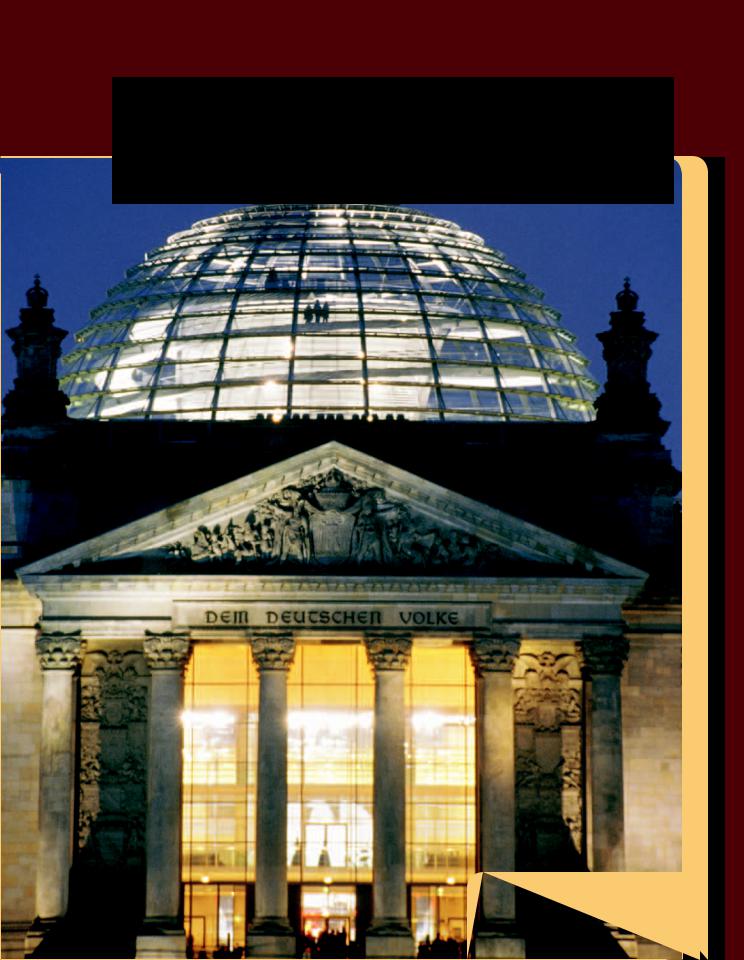
 The Reichstag
The Reichstag
The historic Reichstag in Berlin, Germany, has been updated with state-of-the-art green technology.
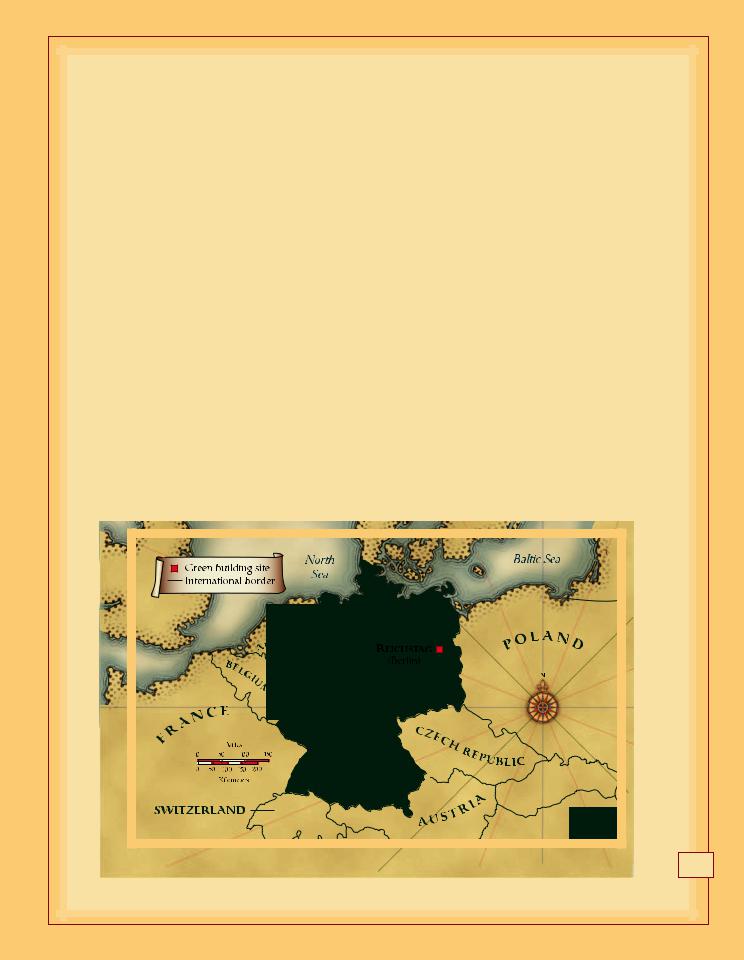
One building in Germany—the Reichstag—
uses green building technology from top to bottom. The
Reichstag is Germany’s parliament building. The people in
parliament are the nation’s legislators, or lawmakers.
History of the Reichstag
The Reichstag has a long and rich history. The Germans built it between 1884 and 1894. The original building had a dome made of steel and glass. The dome was impressive. Many people considered it an architectural masterpiece.
When it was new, the Reichstag housed the government of the German Empire. In 1933 fire destroyed much of the building’s interior, as well as most of the dome. The German parliament stopped meeting there. During World War II (1939–1945), enemy forces attacked Berlin. The attack damaged the Reichstag even more.
39
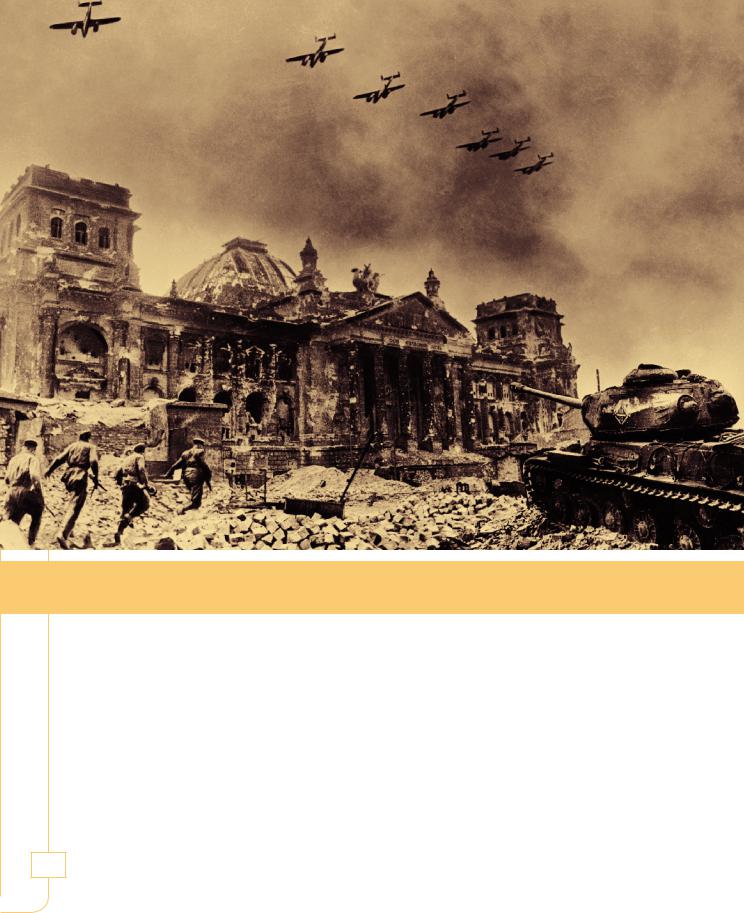
When creating the new Reichstag, Germans did not want to forget their history, including the damage to the building during World War II.
After the war, Germany became two countries. East Germany had one government. West Germany had another government. The Reichstag was in West Germany. But the building no longer housed the government. It sat empty. In the 1950s, West Germans repaired the building and removed its damaged dome. In the 1960s, they turned the building into a conference center, where groups could hold meetings.
On October 2, 1990, East and West Germany reunited as one country. The official ceremony took place at the Reichstag. Shortly afterward, German parliament members agreed to make the Reichstag their meeting place once again.
40
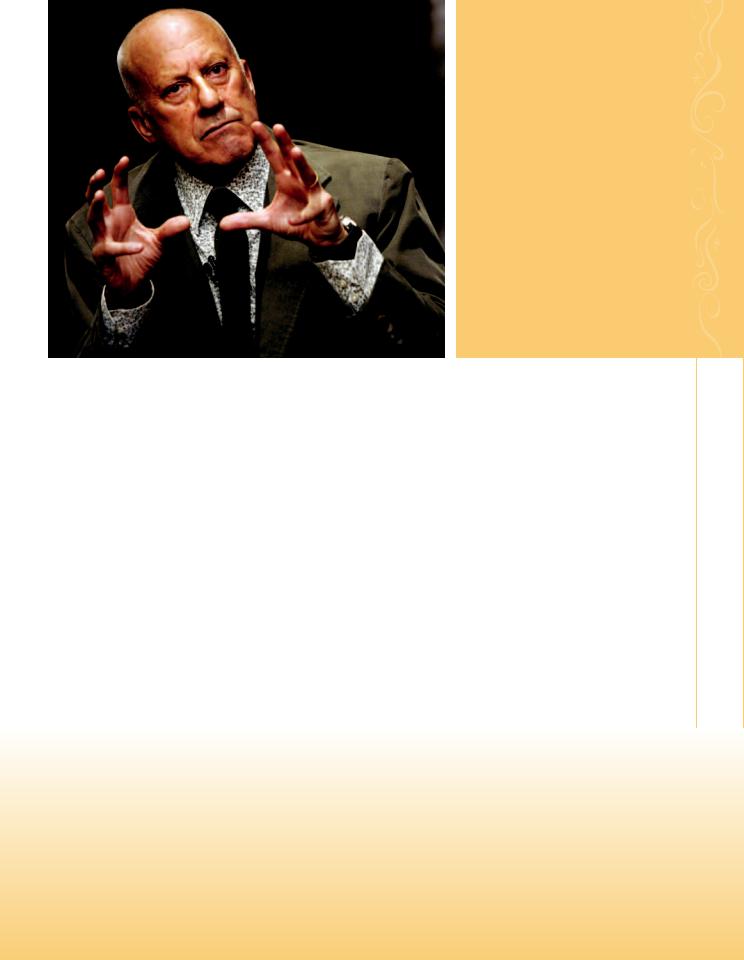
The Reichstag design, created by British architect Norman Foster (left), allows German citizens to see their lawmakers at work.
Redesigning the Reichstag
Before the German parliament could meet at the Reichstag, the building needed to be repaired. In 1993 the German government held a contest to find the best design for the new Reichstag. Norman Foster, an architect from London, won the contest.
Foster’s design focused on three goals. First, he wanted to make German citizens feel more connected to their government. He wanted them to be able to see members of parliament on the job. Second, he wanted to keep as much of the building’s history as possible. Third, he wanted the building to help protect the environment.
To meet the first goal, Foster created one main entrance. Both parliament members and the public use this entrance. They can talk and share ideas as they walk in and out of the building together. On the first floor, Foster designed a big glass wall. It allows visitors to see hallways and parliament members inside the building. He also created a new glass dome in which people could walk around. When people in the dome look down, they can see legislators at work below. These features allow German citizens to see their government in action.
“The [dome allows] people to ascend symbolically above the heads of their elected representatives [in the chamber].”
Reichstag The
41
—Foster + Partners, architects, 1999
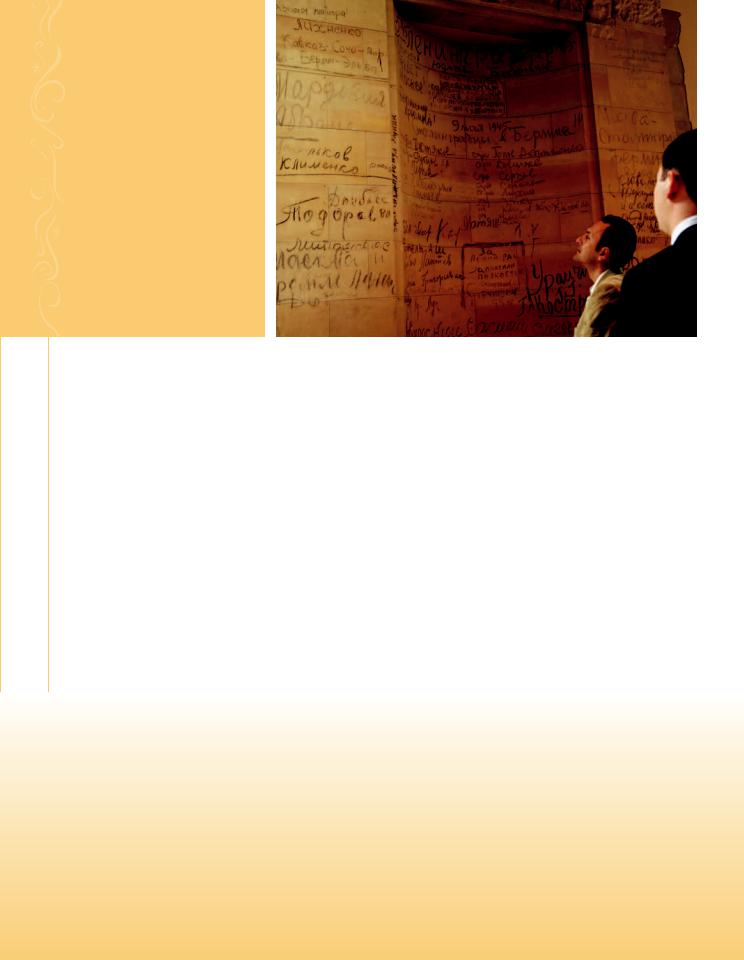
Enemy armies occupied Berlin in 1945. Visitors to the Reichstag can read some of the graffiti that Russian soldiers wrote on the building’s walls.
Seven Wonders of Green Building Technology
42
To preserve some of the building’s history, Foster kept the original layout, or floor plan. He also kept the original outer walls and pillars. Some of them have graffiti, or writing and drawings, from World War II. Enemy soldiers scrawled the graffiti on the walls to insult the Germans. Foster kept the graffiticovered pillars and walls as a piece of history.
The Dome
The Reichstag’s new dome also helps protect the environment. It is one of the building’s most impressive features. The glass-walled dome measures 131 feet (40 m) across. It is 79 feet (24 m) tall and weighs about 1,200 tons (1,089 metric tons).
The dome contains two spiraling ramps. Visitors can walk up the ramps to an observation deck. From the observation deck, people can look through the glass walls and see the city of Berlin around them. They can also look down to see parliament members working below.
“The big glass lantern on top of the Reichstag sparkles with mirrored glass by day and is strobed by light at night, a sign that Berlin is once again the capital of a unified Germany.”
—Nonie Niesewand, “Architecture: Norman’s Berlin Conquest,” 1999
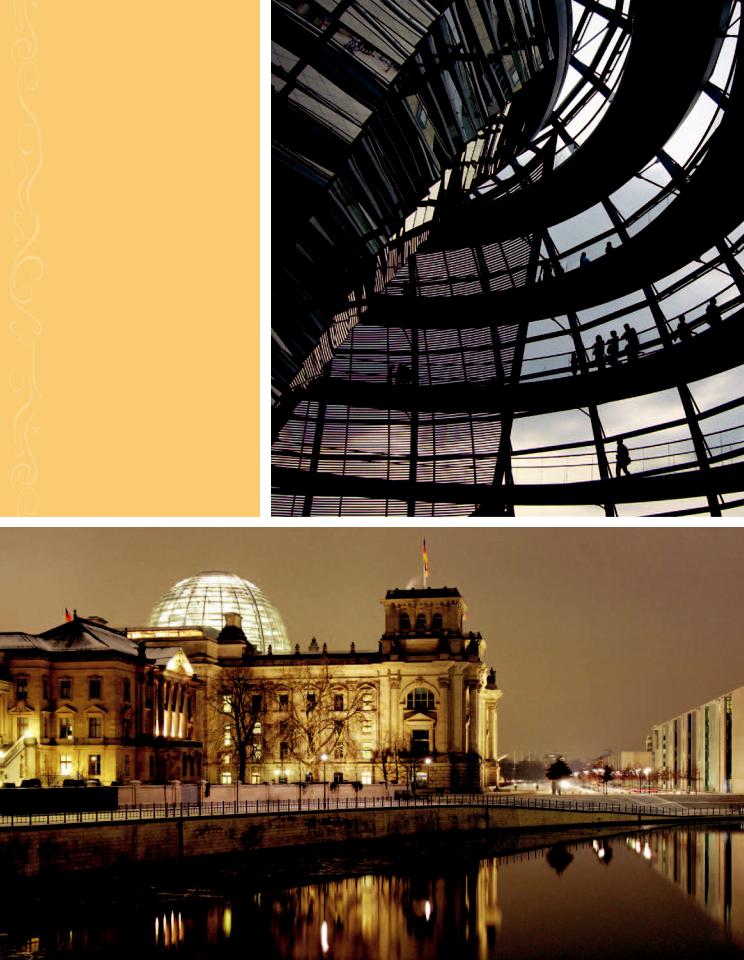
Right: Spiral ramps into the dome give visitors a view of government officials in session on the ground floor, as well as a full view of the city of Berlin. Below: When darkness falls, the dome lights up like a lantern.

Left: Members of Germany’s parliament sit in the meeting chamber, which is lit from above by sunlight reflecting off the dome’s mirrors. Right: Tourists get a look at the mirrored dome from the observation deck.
In the center of the observation deck is a collection of 360 mirrors. Together, the mirrors form an upside-down cone. The cone is beautiful to look at, but it also serves an important purpose. When sunlight hits the cone, the mirrors reflect the light down into the chamber where parliament meets. During the day, the sun and the mirrors provide light for the chamber. This design saves energy, since people do not have to use electric lights in the chamber during the daytime.
44
Indoor
Sun
Architects often design buildings to take advantage of sunlight. Using natural light instead of artificial light is called daylighting. Daylighting reduces the amount of electricity a building uses.
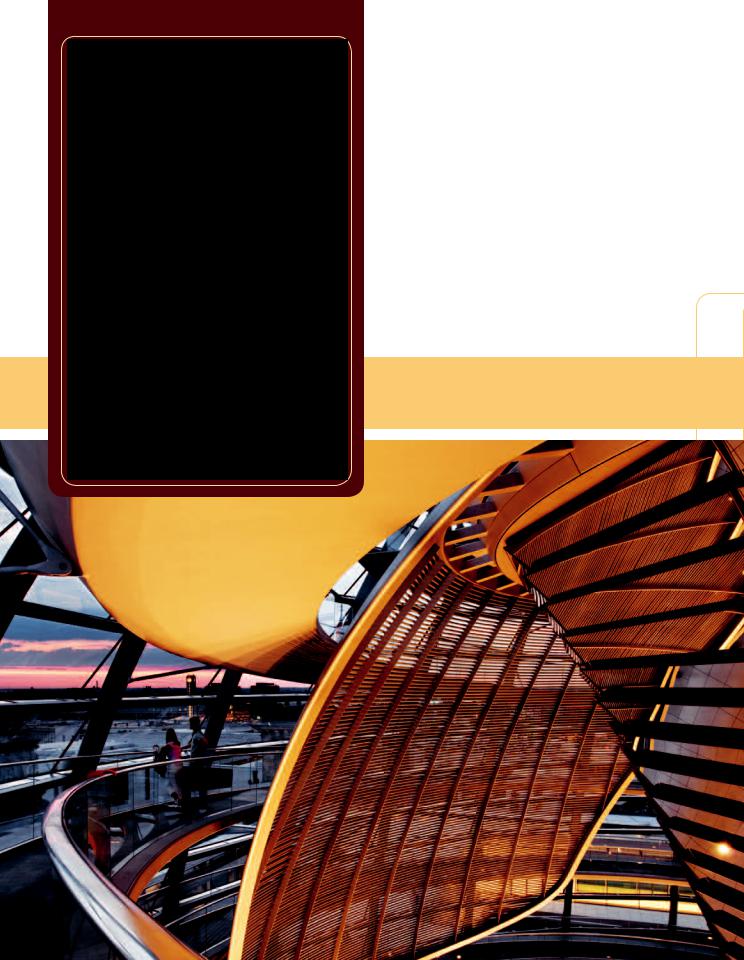
Sunscreen
for the
Reichstag
When direct sunlight bounces off a mirror, the light can hurt your eyes. Architect Norman Foster found a way to prevent this problem in the Reichstag dome. The dome has a movable shield. It keeps sunlight from hitting the
mirrors directly. The shield follows the course of the sun. It moves along the mirrors throughout
the day, blocking sunlight as necessary. A computer controls the shield’s movements.
When it gets dark outside, parliament members must turn on the chamber’s electric lights. The mirrors in the dome reflect the light shining up from below. The reflected light illuminates the dome. In this way, the
dome becomes a lantern. When it lights up in the late afternoon, people outside the building know that parliament members are meeting inside.
As the sun moves through the sky, a shield follows its movements. The shield keeps direct sunlight from hitting the mirrors in the dome.
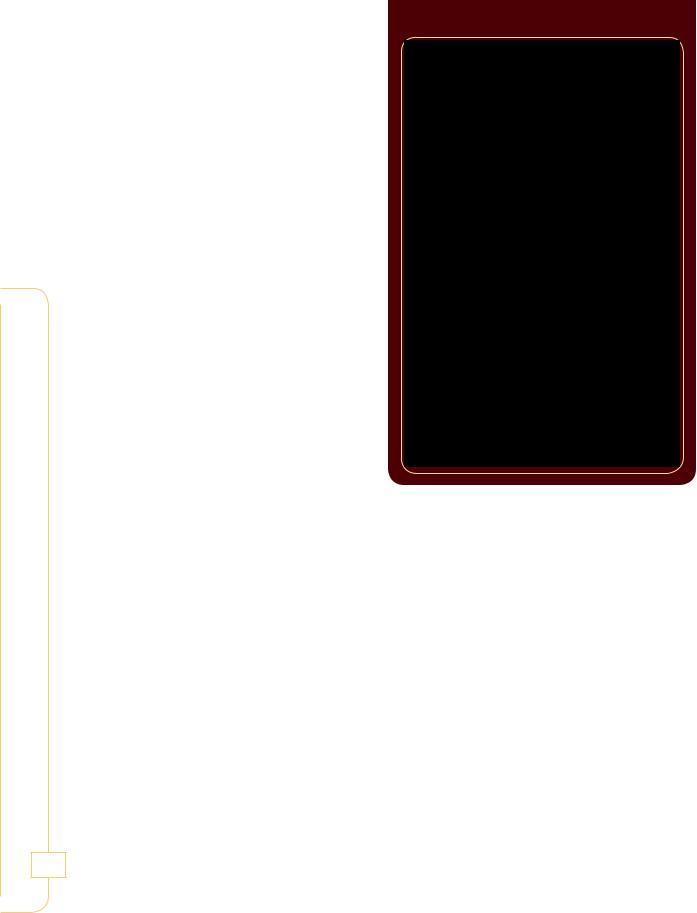
Seven Wonders of Green Building Technology
46
Below the Ground
The top of the building isn’t the only environmentally friendly feature of the Reichstag. The building also has an underground power plant to make
electricity. The plant does not burn fossil fuels. Instead, it runs on vegetable oil. Burning vegetable oil instead of fossil fuels reduces the Reichstag’s carbon emissions by 94 percent.
Two aquifers also sit beneath the Reichstag. An aquifer is an underground layer of rock, sand, and gravel. This layer traps groundwater seeping down from above. One aquifer is 165 feet (50 m) below the Reichstag. The other is 984 feet (300 m) below. Water from the aquifers helps heat and cool the building.
The underground power plant
creates a lot of heat when it makes electricity. The excess heat goes to the bottom aquifer. It makes the water in the aquifer extremely hot. The temperature reaches 158°F (70°C). When the building needs heat, pumps
send the heated water up through pipes to the Reichstag. The heat from the water pipes warms the building.
The Reichstag uses the upper aquifer for cooling. Berlin can get cold in winter. The low temperatures cool the water in the upper aquifer to 41°F (5°C). Even in summer, the water remains very cool. People pump it up through pipes to cool the building, just as they pump up hot water to warm the building in winter.
Builders completed the Reichstag in 1999. Because of its history, its dome, and its environmental features, the Reichstag is one of Germany’s top tourist destinations.
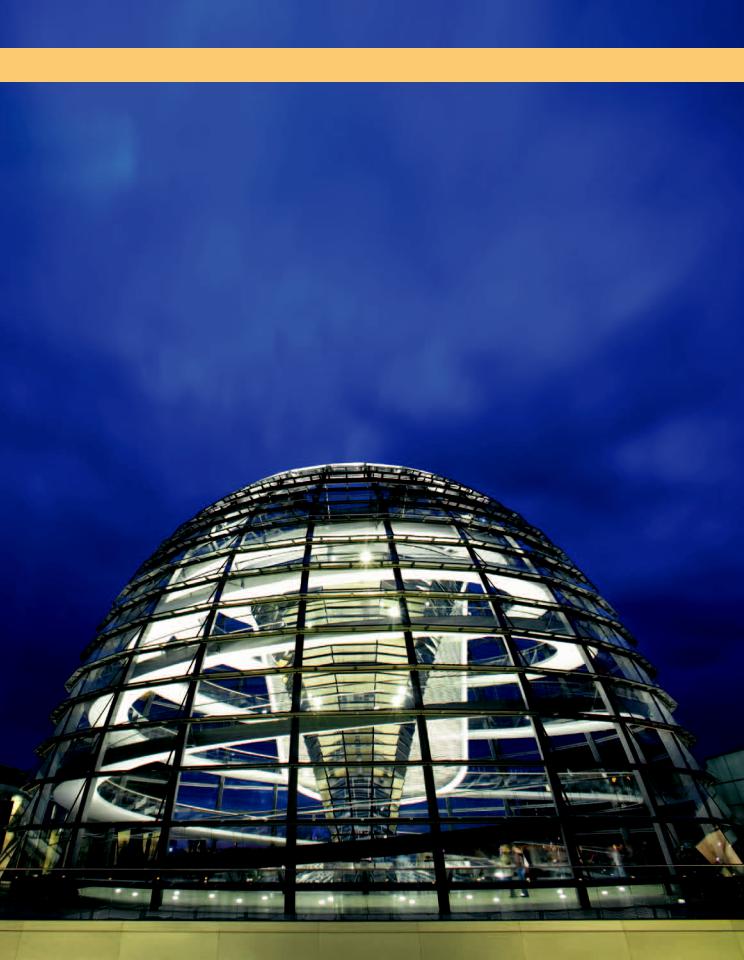
The Reichstag’s dome glows against the dark night sky.
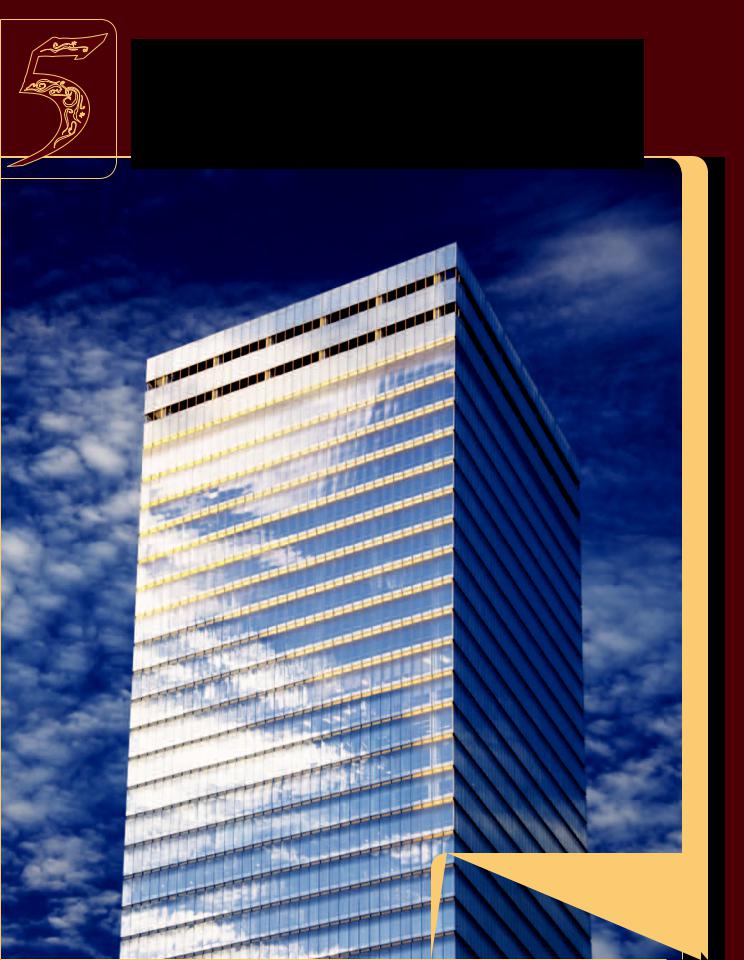
7World Trade
Center
Finished in 2006, 7 World Trade Center is a tall glass building. It stands as a symbol that New York is rebuilding after terrorists attacked the United States in 2001.
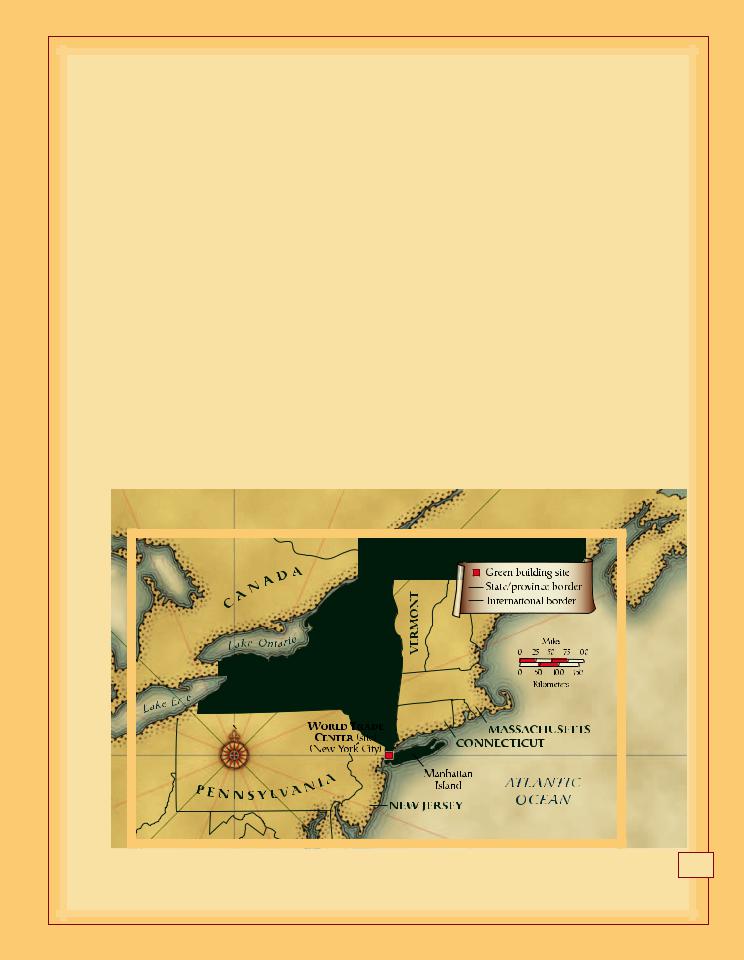
On September 11, 2001, people in
the United States faced a great tragedy. That morning,
terrorists hijacked four passenger airplanes. The hijackers
flew three of the planes into buildings. One plane hit and
badly damaged the Pentagon. The Pentagon is the U.S.
military headquarters near Washington, D.C. Two other
airplanes flew into Tower 1 and Tower 2 (the Twin Towers)
of the World Trade Center (WTC) in New York City. On
the fourth airplane, passengers fought with the hijackers.
The plane crashed in a field in Pennsylvania.
49
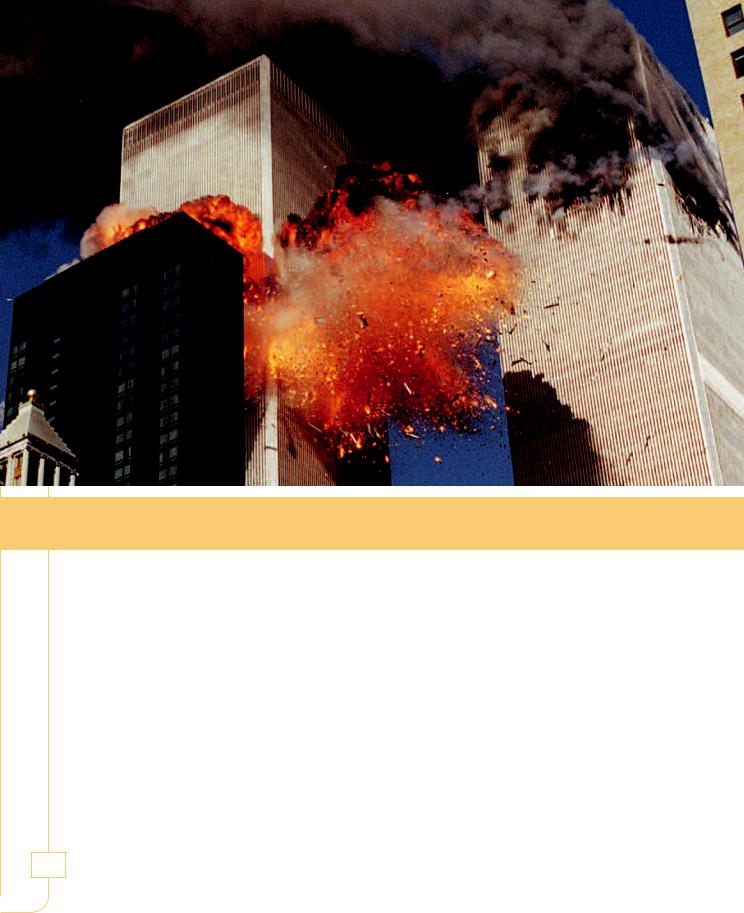
Seven Wonders of Green Building Technology
Glass, flames, and smoke burst out of the two World Trade Center towers after airplanes struck the skyscrapers in 2001.
The World Trade Center is a large business complex in New York City. People from all over the world come there to conduct business. Before the September 11 attacks, the WTC had seven buildings, including the Twin Towers.
The Twin Towers were two of the world’s tallest skyscrapers. After the airplanes struck, the giant skyscrapers burned and collapsed. The fires, debris, and destruction from the Twin Towers caused a third WTC building to collapse. That building was the forty-seven-story Tower 7, or 7 World Trade Center (7 WTC).
Before the Twin Towers and 7 WTC fell, many people were able to leave the buildings. But some people couldn’t get out in time. Altogether, about three thousand people died in the September 11 attacks. Most of them were trapped in the Twin Towers. The attacks on September 11 quickly became known as 9/11. Nine stands for September, the ninth month of the year. Eleven stands for the day of the attack.
50

Measuring
Freedom
The Freedom Tower’s height of 1,776 feet (541 m) is itself a symbol of U.S. freedom. The numbers represent the year 1776, when the nation’s founders signed the Declaration
of Independence. This document stated that the original thirteen British colonies were forming a new, independent United States. Freedom Tower is scheduled to open in 2012.
Filling an Empty Space
After 9/11 New York City was left with a big empty spot and a large gap in the skyline. People wondered what to do with the space where
the Twin Towers and 7 WTC had stood. Should the space be left empty as a memorial to all the people who died there? Should the city build a park in their honor? Or should people construct new buildings to replace the ones that had fallen?
In the end, New Yorkers decided to let the world know that the 9/11 attacks had not
defeated their city but had made it stronger. They decided to build five new towers. The towers will be bigger and safer than the original WTC buildings. One building, Freedom Tower, or 1 World Trade Center, will be the tallest building in the United States. It will soar 1,776 feet (541 m) into the air. New Yorkers also decided to build a memorial park and a museum at the WTC site.
The Twin Towers site smoldered for days after the 9/11 attacks. New Yorkers decided to build new towers and a memorial to the people who died there.
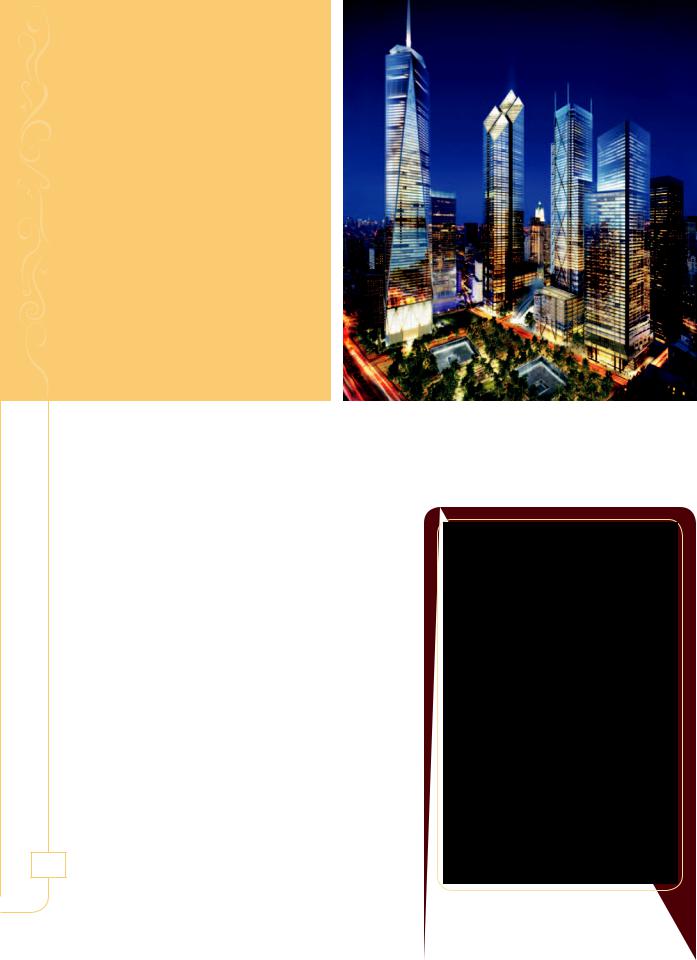
Seven Wonders of Green Building Technology
52
An artist’s model of the new World Trade Center site shows Freedom Tower on the far left and 7 WTC immediately to the right of Freedom Tower.
Green Certified
New Yorkers had another idea as well. Since they were building brand-new towers, why not use the newest technology to make the buildings green? People wanted the new towers to use less
energy, produce less waste, and have cleaner indoor air than the original buildings did.
In 2002 builders put the plan into action. They started with 7 WTC. In 2006, after four years of construction, 7 WTC became the first of the new WTC towers to open its doors. It was also the first skyscraper in New York City to be green certified by the U.S. Green Building Council. To be green certified, 7 WTC had to meet many requirements. It had to:
• Reduce waste (by using recycled materials, for example)
• Save energy and water
• Be healthier and safer for people than traditional buildings
• Reduce carbon emissions
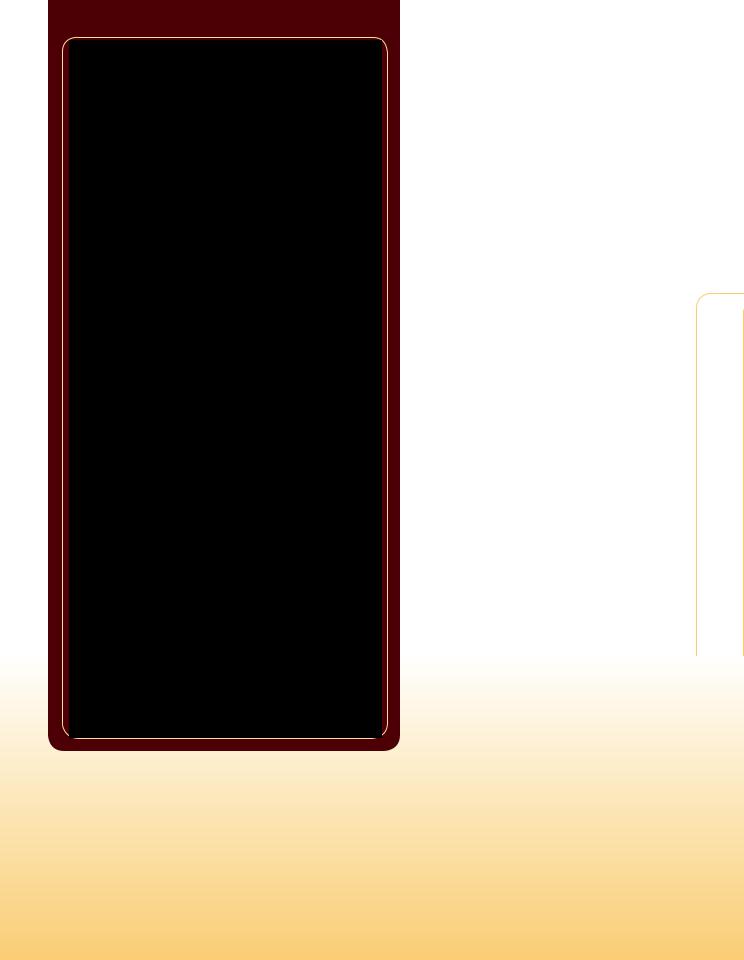
The Many Uses
of Rainwater
People have been harvesting rainwater for thousands of years. In the ancient Middle East, farmers dug ditches to collect rainwater for their crops.The ancient Romans used rainwater to fill bathing pools inside their homes.The water from the pools also made houses cooler.
Collecting rainwater makes good sense. Rainwater can be used to water plants, flush toilets, and cool buildings. People can use filters and other devices to clean rainwater, making it safe to drink. And rainwater is free and easy to collect.
Collecting rainwater is also good for the environment. During heavy rainstorms, water can wash topsoil into rivers and streams. Plants need topsoil for its nutrients and to hold their roots in place. By collecting rainwater, people make sure that soil doesn’t wash away in the rain. Heavy rains can also cause flooding. If enough people harvest rainwater, they can reduce floods.
Rainwater
Harvesting
The rooftops of buildings are good places to harvest rainwater for future use. Gutters located on rooftops can channel water to large tanks at ground level or underground.
Designers included a rainwater harvesting system at 7 WTC. Some of the harvested rainwater travels through pipes to the grass and plants around the building. The rainwater also travels through pipes within the building’s walls. On hot days, the water cools the building and reduces the need for airconditioning.
Harvesting rainwater saves 7 WTC a lot of money on its water bill. The building uses about 30 percent less water than most other skyscrapers. That’s a savings of about 1 million gallons (3.8 million liters) of water a year.
“We have reclaimed an important part of the downtown skyline, and in doing so, we have set new standards in environmental quality, life safety, and innovation.”
—Larry Silverstein, World Trade Center developer, at the 7 WTC grand opening, 2006
World 7 Center Trade
53
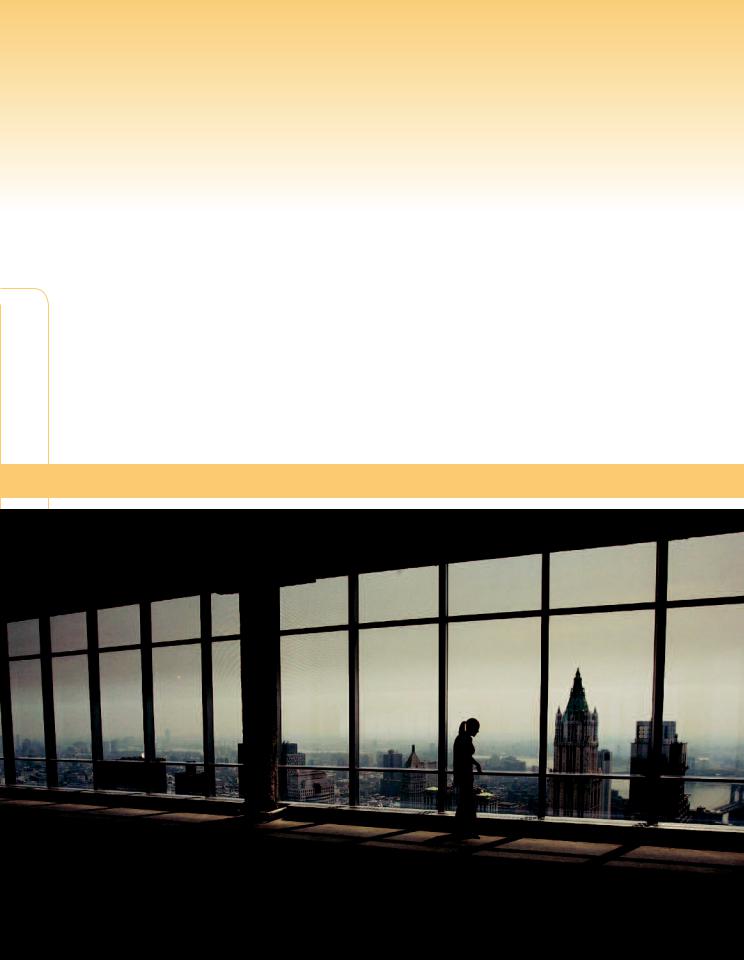
“The World Trade Center is a living symbol of man’s dedication to world peace.”
—Minoru Yamasaki, chief architect of the original World Trade Center, 1966
Other Environmental Features
To save resources, the 7 WTC builders used recycled materials whenever possible. Thirty percent of the steel used to build the structure was recycled. It came from old buildings and other steel structures that had been torn down. Much of the wall insulation was also recycled.
The building has a lot of windows. During the day, instead of turning on electric lights, office workers rely on natural sunlight streaming through the windows. As the sunlight fades in the afternoon, the building’s electric lights automatically get brighter. Working in natural sunlight makes people feel better, but some of the sun’s rays can damage skin. So the 7 WTC windows are made from a special glass. It protects people from harmful rays from the sun.
Big walls of windows allow sunlight to pour into the top floor of 7 WTC.
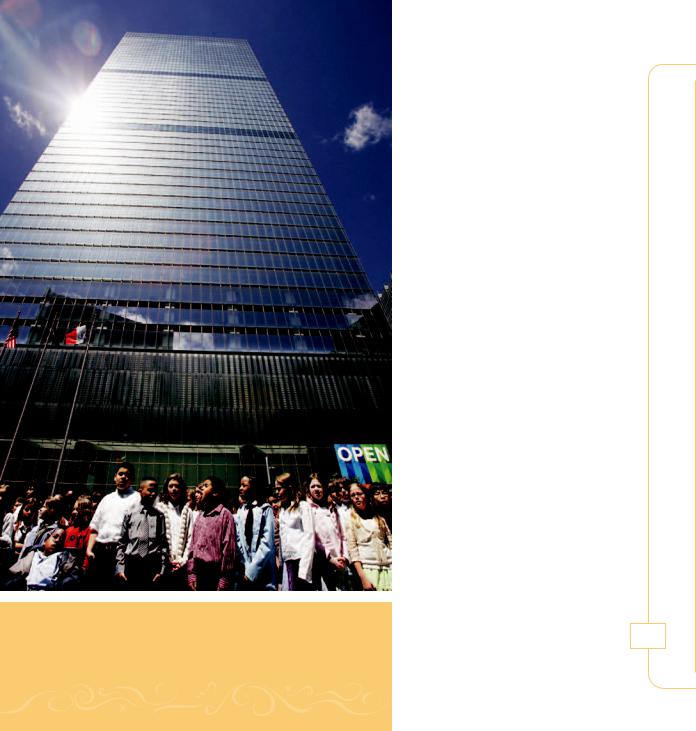
Safety First
The new 7 WTC is taller than the old one. It has fifty-two stories. It’s stronger too. It has a steel structure. Its concrete walls are 2 feet (0.6 m) thick. Many of the construction materials are fireproof. If a fire does break out, the building is designed to keep it in one spot.
The builders did other things to increase safety. The stairwells are wider than they are in older skyscrapers. Wide stairwells allow a lot of people to use the stairs at the same time. During an emergency, office workers can exit quickly without crowding one another.
Many different companies rent office space in the tower. Workers appreciate the added safety
features. But on a daily basis, some of the greatest benefits come from the building’s green features.
World 7 Center Trade
New Yorkers held a special ceremony when 7 WTC opened in |
55 |
2006. A group of schoolchildren sang at the ceremony. |
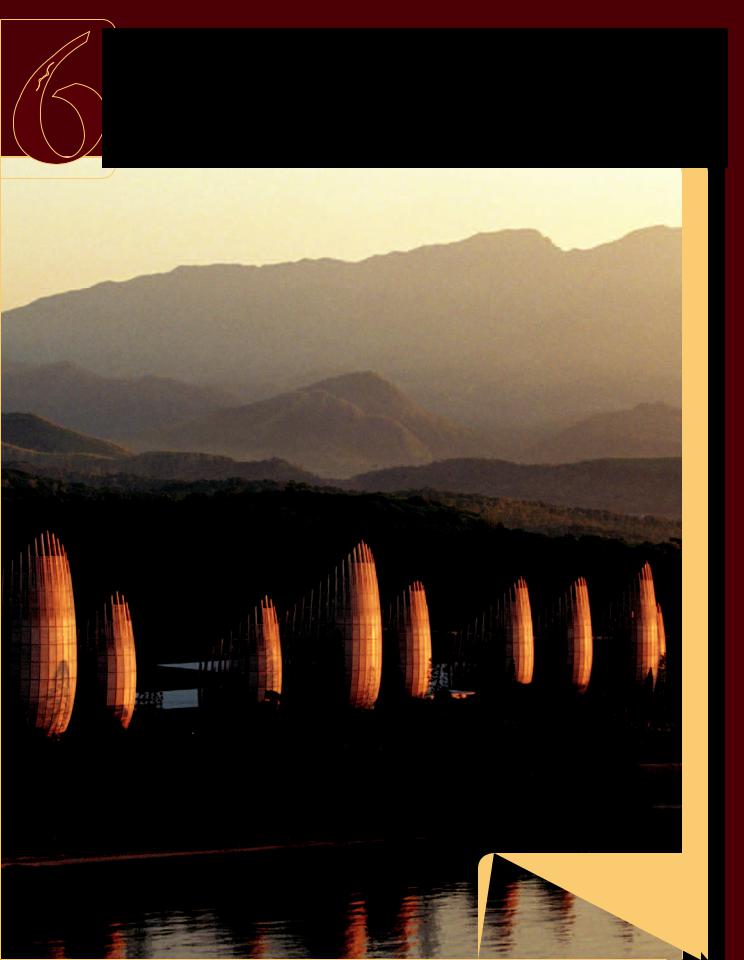
Jean-Marie Tjibaou


 Cultural Center
Cultural Center
The Jean-Marie Tjibaou Cultural Center in New Caledonia honors Kanak culture and traditional Kanak housing.
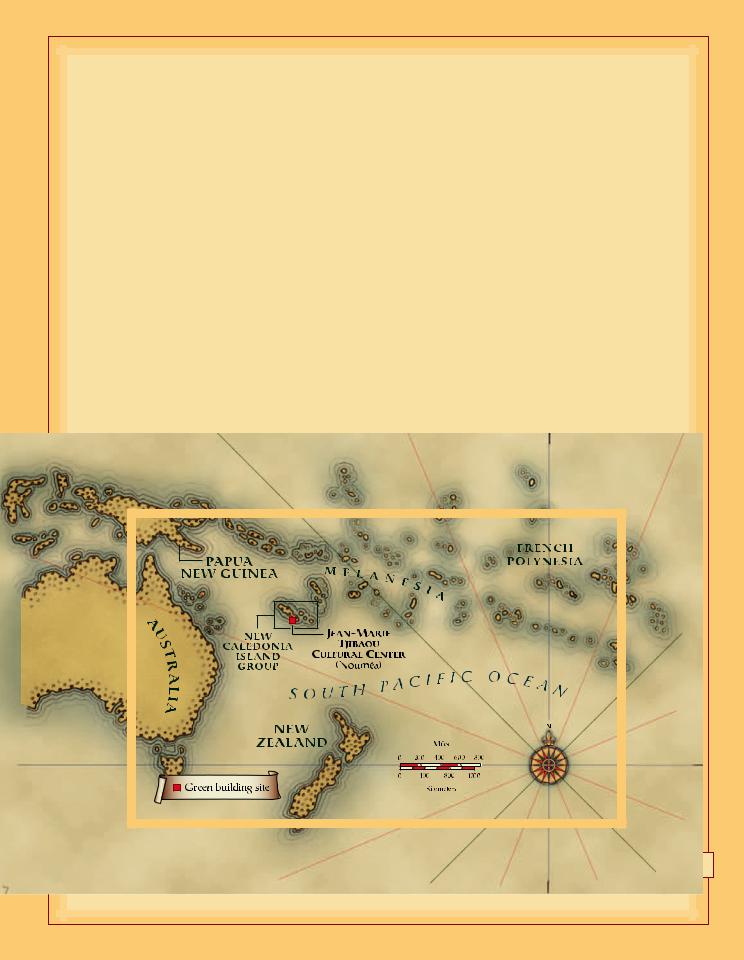
New Caledonia is a small group of
islands in the South Pacific Ocean. The islands are just east of Australia. Since 1853 New Caledonia has been a
French territory. France has some control over how New
Caledonians govern their islands.
About 250,000 people live on the islands. About 45 percent of them are native Pacific Islanders. They belong to an ethnic group called the Kanaks. The Kanaks have lived on the islands for thousands of years. About 34 percent of the people in New Caledonia are of French or other European ancestry. The rest of the islanders trace their ancestry to other places in Asia.
57
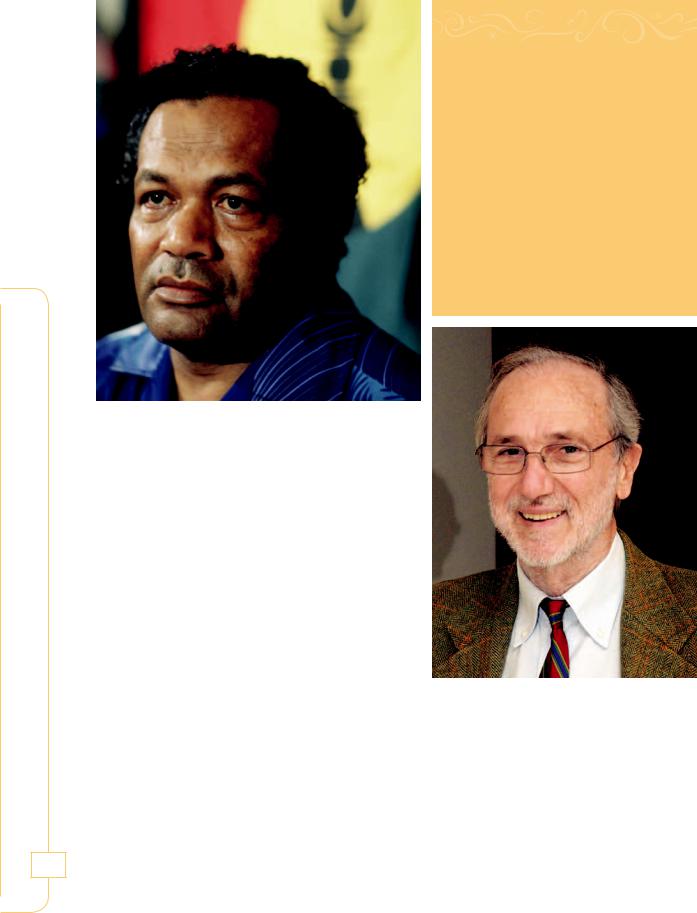
The cultural center is named after New Caledonia leader Jean-Marie Tjibaou (left), who was killed in 1989. Architect Renzo Piano (below) built the center to suit the tropical climate.
Seven Wonders of Green Building Technology
Mountains, pine trees, waterfalls, and white sandy beaches cover the islands. Lagoons and coral reefs lie offshore. Nouméa is the nation’s capital city. It has many French restaurants and shops. The buildings in downtown Nouméa are mostly European-style buildings. The French built them during the 1800s and 1900s.
About 6 miles (10 kilometers) north of downtown sits the Jean-Marie Tjibaou Cultural Center. It is one of the most interesting structures in Nouméa.
The Center
In 1989 an assassin killed Jean-Marie Tjibaou, New Caledonia’s leader. Tjibaou was a Kanak. He wanted New Caledonia to be free of French rule. After Tjibaou’s death, the French government wanted to honor Kanak culture.
The government hired Italian architect Renzo Piano to design a place to showcase Kanak history and the Kanak way of life. People chose the name Jean-Marie Tjibaou Cultural Center to honor the slain Kanak leader.
58
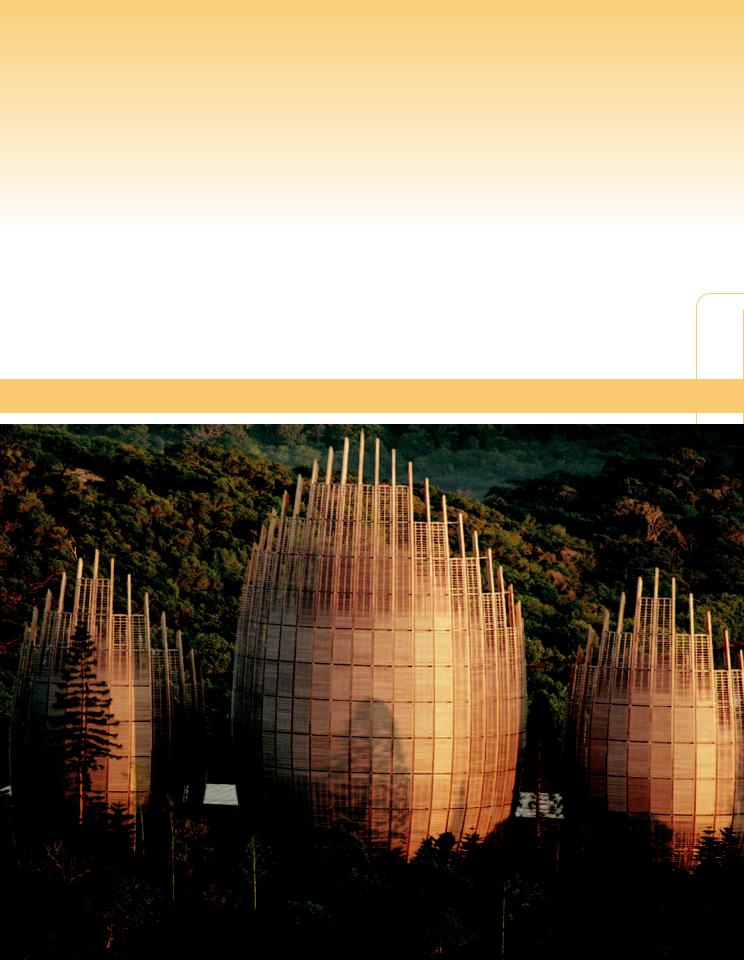
“Piano’s architecture . . . is shaped not just by function and technology but also by the place and its traditions, and by an urge to settle into and integrate with the surroundings and nature.”
—Peter Buchanan, Renzo Piano Building Workshop, 1999
Builders completed construction in 1998. The design blends modern building techniques with traditional Kanak architecture.
The center features ten wooden structures. Piano designed them to look like traditional Kanak great houses, or ceremonial houses. The tallest one is nine stories high. The houses are separated into three groups, called villages.
Built of tough iroko wood, the ten wooden structures can withstand fierce tropical storms.

Above: This aerial photograph shows the wooden housing and the walkway connecting it. Below: One of the gardens at the center grows banana trees and other native edible plants.
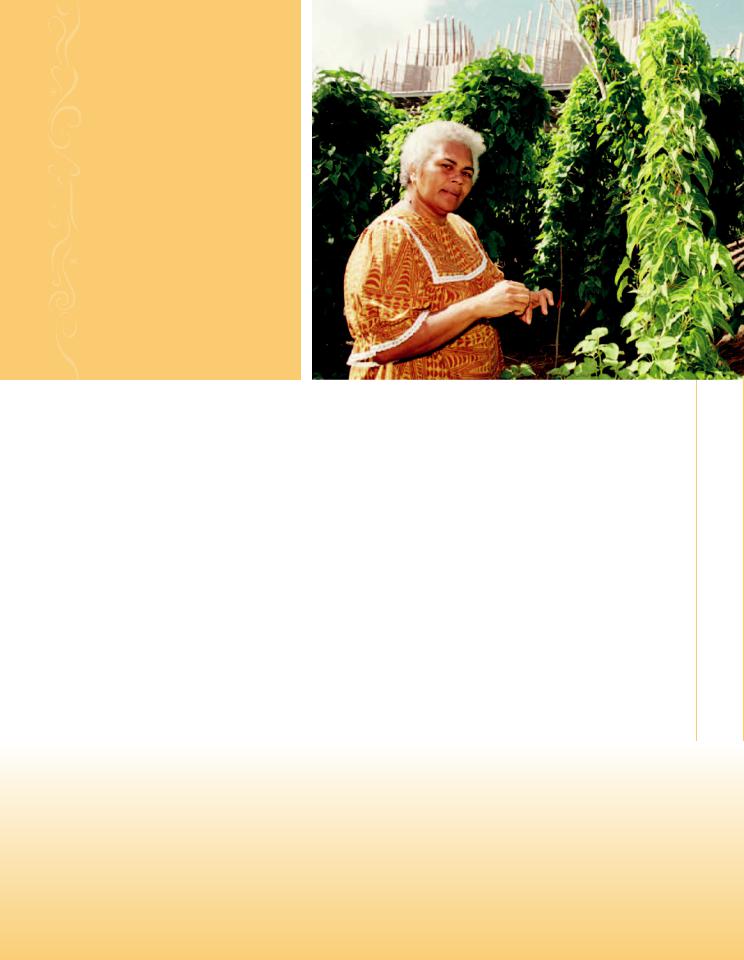
Marie-Claude Tjibaou, Tjibaou’s widow, walks through the gardens at the cultural center.
The center is a place where researchers can study Kanak culture. It includes an outdoor auditorium. It also has rooms for visiting artists, lecturers, scholars, and students.
Lush gardens surround the center. The gardens symbolize the history and culture of the Kanak people. According to Kanak mythology, the world began with only the sky, the moon, and the sea. One day the moon dropped a tooth into the sea. The tooth turned into worms, lizards, and other animals, including people. One garden at the cultural center has a pond with a rock in it. The rock symbolizes the dropped tooth and the birth of the Kanak people.
Another garden displays the plants that Kanak people traditionally used as medicines. It also has yams, bananas, cabbage, and taro. Kanak cooks commonly use these plants in cooking. A third garden displays plants that Kanaks typically grow near their homes. These include araucaria trees and coconut trees. A fourth garden has cordyline plants. When giving gifts to
friends, family, or visitors, Kanaks place the items in the red leaves of this plant. The gardens are symbols of Kanak culture. And the plants serve the
environment. They absorb carbon dioxide, reducing the center’s carbon footprint.
“The cultural center in Nouméa for the preservation of the Kanak culture by Renzo Piano represents a perfected masterpiece.”
Marie-Jean
Cultural Tjibaou
Center
61
—Werner Blaser, Renzo Piano: Centre Kanak, 2001
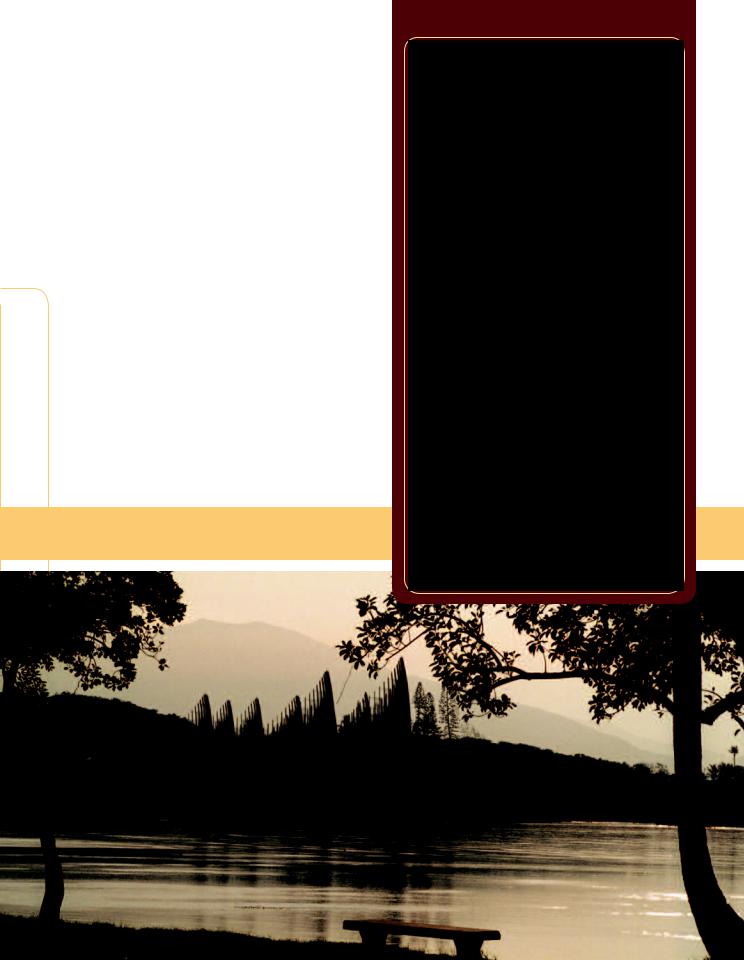
Building for the Weather
When designing the cultural center, Renzo Piano considered its location. The center sits on the narrow Tina Peninsula. A peninsula is a piece of land surrounded by water on three sides. On one side of the cultural center lies the calm water
of a lagoon. On the other sides are the Bay of Magenta, which merges with the rough waters of the Pacific Ocean. Piano also considered New Caledonia’s tropical climate. The islands are generally warm and humid. Sometimes, cyclones, earthquakes, and tsunamis (tidal waves) hit the islands.
To help protect the center from violent weather, Piano built it from iroko wood.
The cultural center sits between a lagoon (below) and the Pacific Ocean.
Storm
Warning
Cyclones are violent tropical windstorms. In North America, we call these storms hurricanes. Tsunamis are giant ocean waves.
Undersea earthquakes often trigger tsunamis. In March 2003, a tropical cyclone pounded New Caledonia’s west coast, including theTina Peninsula.The storm’s powerful winds tore off roofs, uprooted trees and crops, and knocked down power lines.The storm also killed two people, injured more than
one hundred, and left about one thousand homeless. But because of their strong iroko wood walls, the buildings of the Jean-Marie Tjibaou Cultural Center remained unharmed.
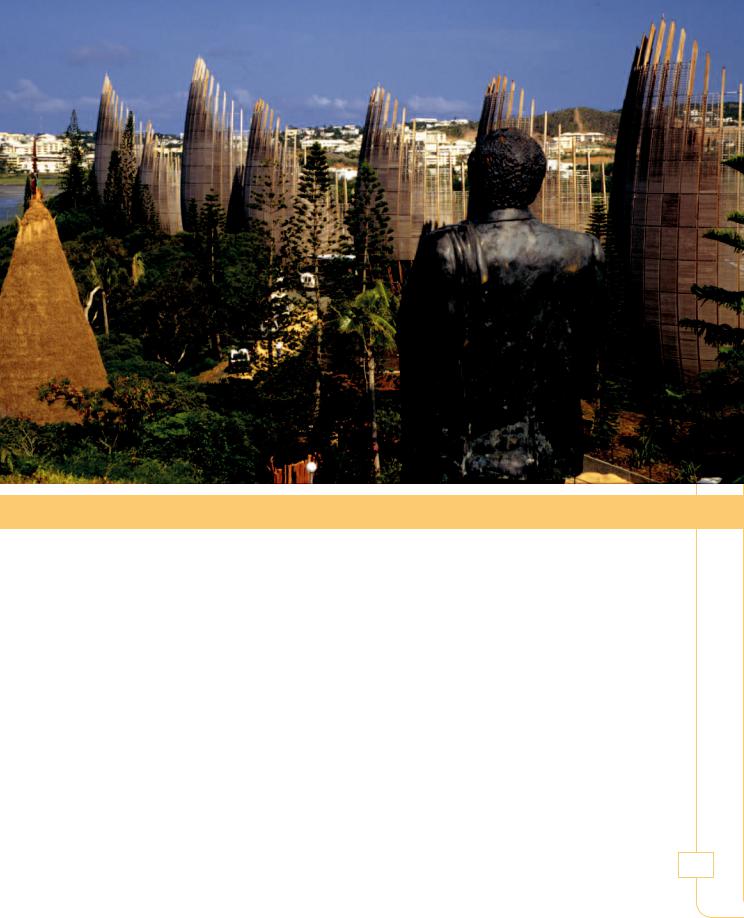
A statue of Jean-Marie Tjibaou looks out over the cultural center.
This wood is very strong and durable. People sometimes use it to build boats. Iroko does not rot easily. It is hardy enough to withstand strong ocean winds.
Piano didn’t just want to protect the buildings from ocean winds. He wanted to use the winds to cool the buildings. The great houses each have two layers of louvers. The outer louvers are made of wooden slats. After ocean winds filter through the slats, they reach the second layer of louvers. The inner louvers are made of glass. They automatically open or close, depending on
the speed of the wind. The double louvers allow fresh air into the buildings. During violent storms, the louvers control how much wind enters the buildings. The louvers also force warm air upward toward the ceiling. This process helps cool the lower part of the buildings.
The cultural center is a tribute to the Kanak people in many ways. Through its design, it honors their culture and history. It also honors nature and the idea of living in harmony with the environment.
Marie-Jean
Cultural Tjibaou
Center
63
